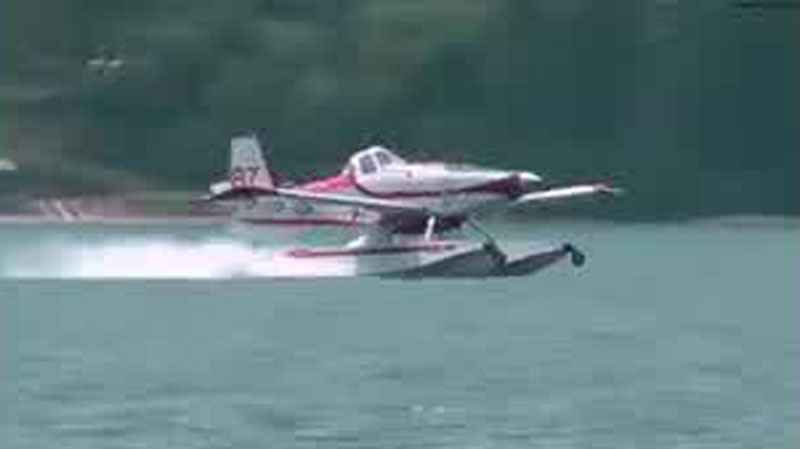Fire Boss aircraft created in Minnesota changing wildfire strategy worldwide

(KSTP/file)
Minnesota companies are changing the strategy for fighting wildfires around the world and they’re saving taxpayers a lot of money.
We’ve all seen crop-dusters flying low to spray a farm field. But you probably haven’t seen those same planes flying low to put out a wildfire.
John Schwenk is an old crop duster who never thought he would be fighting wildfires.
“No I did not, no. It just came along by circumstance,” he said.
Schwenk is the former owner of Aero Spray in Appleton, Minnesota. The company is now called Dauntless Air. He specialized in flying the Air Tractor AT-802. It’s built in Texas and is known as the world’s most powerful agriculture aircraft.
Then in 2003, Wipaire, a third generation family business in South St. Paul, put the 802 on floats and the Fire Boss was born.
“It was a game-changer,” said Schwenk. “It was a game-changer for the whole firefighting industry.”
Chuck Wiplinger runs Wipaire. His grandfather Ben founded the company in 1962. His father Bob came up with the idea for the Fire Boss in 2003. The company has 175 employees, mostly in South St. Paul and Inver Grove Heights. They sell airplanes and manufacture and install floats on planes.
The Fire Boss is a unique plane. It has thermal imaging to target hot spots, an onboard system that blends gel with water to make drops more effective and floats with a unique water scooping mechanism.
“And as we approach the water these come down and we land on the water and we’re doing about 60 mph across the water,” said Wiplinger. “It pushes water up through a tube, up through the float and into the hopper of the aircraft where the water is contained. We’re taking in anywhere from 600 to 800 gallons depending on the fuel load on the aircraft.”
The whole process only takes about 15 seconds. That allows the plane to get back to the fire and drop its load much faster than other aircraft that have to return to the airport.
“So the Fire Boss is being focused to do direct attacks on fires,” said Wiplinger. “And it makes it very cost-effective to do direct attack. We are significantly cheaper than another firefighting aircraft out there.”
The Minnesota DNR played a role too. They were looking for a way to save taxpayers money fighting wildfires and the Fire Boss was the answer.
“And they did extensive studies and demos on it,” said Schwenk. “And when they finally determined what it was capable of doing and what it did, then they embraced a little longer term contract.”
According to Matt Woodwick, assistant DNR wildfire aviation supervisor, it cost less to sign contracts for six Fire Bosses than it did for the state of Minnesota to own the two firefighting CL-215 aircraft it had. Plus, the Fire Bosses could respond to several fires at the same time.
“We decided to go with the Fire Boss because we thought the costs could be less,” said Woodwick. “Initially it was difficult to estimate how much if any money would be saved until a contract was bid and awarded. Once the contract was awarded we did see a projected savings of over a million dollars annually compared to the CL-215’s.”
“All of a sudden we got a tool, especially in places like the state of Minnesota where you got water and you got wildfires close by,” said Schwenk. “We could put like 10 loads on to every one of theirs sometimes, depending how far away the water is or the airport is.”
Wiplinger believes the Fire Boss is saving lives.
“I’m sure it is,” he said. “It is putting out lots of fires. It is getting in there quickly and it can maneuver in tight places. So where you have structures you can get in and get around them.”
The Fire Boss is changing the strategy for fighting wildfires all over the world. As a result, Wipaire has become a global company and Dauntless Air no longer does agriculture, it only fights wildfires.
“This aircraft has obviously lots of Minnesota pride,” said Wiplinger. “My family is from Minnesota, we’re all from Minnesota, and we grew up here.”
Right now, seven Dauntless Air Fire Bosses are fighting active fires in Washington and Nevada. There are two based in Bemidji, but luckily there are no fires burning in Minnesota.
According to Dauntless Air, 2018 has been the company’s busiest fire season since it began fire operations in the late 1990s. This season, Dauntless Fire Boss utilization is up by nearly 60 percent over last year. The company has fought fires across more states than ever before. One Dauntless Fire Boss was called up into Canada to help combat fires in Northwestern Ontario.
On average there are more than 15,000 wildfires in Minnesota each year, and more than 72,000 nationally. According to the 2017 Annual Report on Emergency Firefighting Expenditures, in fiscal year 2017 the state spent $23,432,522 for wildfire protection and emergency response by the DNR. This includes an Emergency Firefighting Open Appropriation of $16,271,730.
You can keep track of where wildfires are burning in Minnesota and other states through the National Interagency Fire Center.